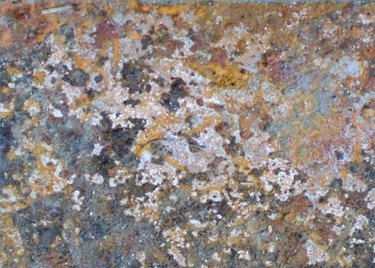
Mold is a type of fungus that can grow in many different places around the house where moisture builds up, including kitchens, bathrooms and attics. Controlling mold in the home is important because it may cause or exacerbate certain respiratory conditions, such as asthma. Several common household chemicals can be used to kill mold, and there are natural solutions as well. Prevention, however, is the best strategy.
Tip
Bleach, borax and vinegar are some of the products that can kill mold growing around the home.
Video of the Day
Chemicals That Kill Mold
A number of common household cleaning products can be used to kill mold, including bleach, which can be combined at a ratio of 1 cup of bleach per 1 gallon of water in a spray bottle to make a potent anti-fungal solution. In fact, bleach not only kills mold, but also inhibits its growth, although its fumes might make it prohibitive in some situations. Make sure the area is well ventilated and wear a respirator mask when using bleach.
Borax, which is often used as a deodorizer, is another option for killing mold, and unlike bleach, it doesn't produce fumes. The Mississippi State University Extension recommends a ratio of 1 cup of borax to 1 gallon of water. Ammonia can also be used on its own to eradicate mold. However, it is important to never mix ammonia and bleach, as the combination produces toxic fumes.
Video of the Day
Natural Mold Removers
If the mold problem in your home is not severe and you would rather not resort to harsh chemicals, natural products that you might already have around the house can help reduce, eliminate and prevent mold growth. For example, Country Living magazine recommends using a solution made of 1 teaspoon of tea tree oil, an essential oil used in skincare, per 1 cup of water. Spray the affected surface and allow the tea tree oil solution to dry for at least an hour before wiping down the area.
For mold in upholstered furniture, Country Living magazine recommends using a 3 percent hydrogen peroxide formula. Combine 1 part hydrogen peroxide to 3 parts water in a spray bottle and soak the affected area. Distilled white vinegar, which is sold in grocery stores, can also be effective at removing mold, as it can kill 82 percent of mold species, according to the Mississippi State University Extension. You can apply the vinegar directly on the moldy area without having to dilute it with water. For light mold stains, you can also create an antifungal paste by combining equal parts baking soda and water.
Controlling Mold Growth
One of the reasons mold can be such a nuisance is that it will regrow as long as conditions are right. The best way to limit mold levels in your home is to reduce moisture as much as possible, which eliminates the need for chemicals. For instance, fixing leaky pipes is key to avoiding mold buildup inside walls and underneath kitchen and bathroom sinks.
Ventilating areas where moisture accumulates, like the kitchen, by opening windows or running exhaust fans, is also a good idea. During humid periods, running an air conditioner or dehumidifier can help. The CDC also advises against installing carpets in rooms that may harbor excess moisture, as mold can grow below the carpet where it will eventually ruin the carpet.